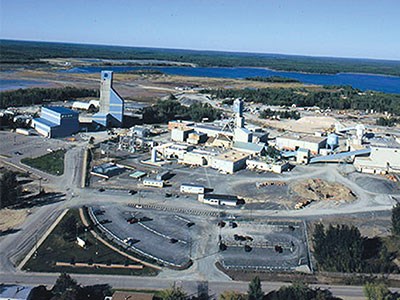Goldcorp is advancing toward refurbishing a former producing mine and finishing an underground haulage tram to access a new deposit at its flagship Red Lake mine complex in northwestern Ontario.
The Cochenour Mine project is a huge part of the mining giant's future plans and longevity in the rich Red Lake district.
A scoping study projected a mine life of 20 years producing between 250,000 and 275,000 ounces of gold annually. The initial capital expenditure is $540 million with the commencement of operations in the first half of 2015.
Together with North Bay-based mine builders Redpath, Goldcorp has been refurbishing the Cochenour shaft, which operated between 1939 and 1991, in order to gain underground access to the highgrade Bruce Channel deposit.
Goldcorp acquired the deposit from Gold Eagle Mines in 2008. As a discovery, it was considered one of Canada's greatest gold finds, located smack dab in the heart of the Red Lake camp. The deposit is under Red Lake in a channel between the mainland and McKenzie Island.
The property is west of Goldcorp's Red Lake and Campbell Mine complex, and is just southwest of an old producer, Goldcorp's Cochenour-Willans Mine, which closed in 1971.
The Cochenour project entailed construction of a new concrete headframe and dewatering of the mine, along with installing surface infrastructure.
Work in the shaft involved stripping old timbers out of a smaller rectangular shaft and widening it to a circular shaft.
Elizabeth Howell, Cochenour project manager, said the headframe, hoists and collar house have been completed.
“We're still in sinking mode in the headframe.”
Howell said the shaft has been sunk to the 3,300 feet level while on the path to reach 3,662.
A study of the project indicated the middle of the Bruce Channel deposit ore body was lower than expected, resulting in the shaft being deepened.
Shaft completion is scheduled for the first quarter of 2014.
A five-kilometre underground haulage drift, is now under construction, and will feature a high-speed tram instead of using trucks on surface.
Constructed at the 5,400-foot level, the drift will efficiently haul ore from Cochenour to the processing facilities at Goldcorp's Campbell milling operations.
The installation of rail inside the drift is two-thirds complete and once in operation, it will handle 1,500 tonnes of ore per day.
With the Bruce Channel deposit located on the down-dip from the Cochenour Mine, the drift will also serve as an underground exploration platform to test the ground in one of the world's most high-grade, deep and geologicallycomplex camps.
Drilling stations have been fitted out at 400-foot intervals to continue exploration along the prolific mine trend.
“We have drill cutouts all the way on both sides of the tram,” said Howell. “As we're driving this tram, we can utilize it as a platform to see what else is out there.”
Premier Gold signed on to a joint venture with Goldcorp to drill off the prospective Rahill-Bonanza property at depth.
Overall, Howell said the project remains on schedule for the 2015 end date.
“Last year were maintaining schedule on the haulage drift,” said Howell, “and even on the shaft this year, we've actually gained a little bit.”
In its third quarter results released in October, Goldcorp reported that Red Lake production checked in at 97,000 ounces at an all-in sustaining cost of $986 per ounce and $640 per ounce on a by-product basis.
The company said gold production during the quarter was lower than the second quarter of 2013, but the entire mine complex remains on track to meet gold production guidance for the year of between 475,000 and 510,000 ounces.




